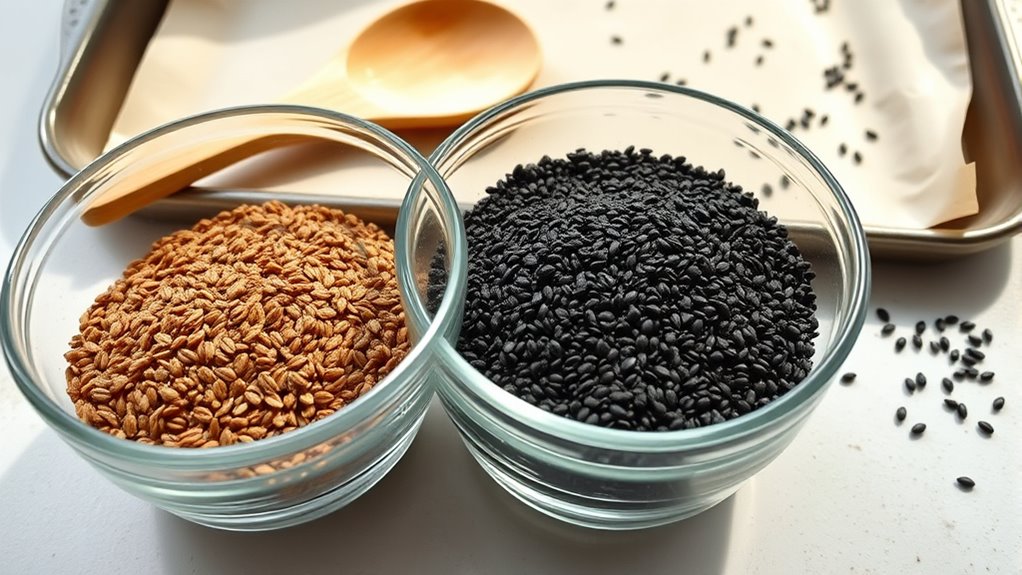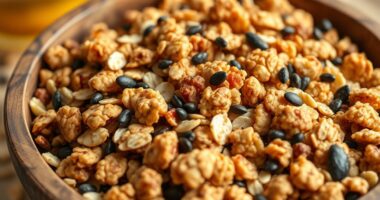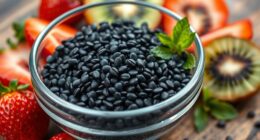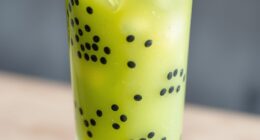When baking with chia versus flax seeds, choose based on texture and nutritional goals. Chia seeds add a subtle crunch and create a gel when soaked, making them great as a binder or egg replacer, while flax seeds, especially when ground, offer a nutty flavor and dense crumb. Whole flax adds crunch, and ground flax boosts moisture and nutrition. To optimize your baked goods, consider how each seed’s properties impact texture and flavor—more details are waiting for you.
Key Takeaways
- Chia seeds create a gel-like binder or add crunch, while ground flax seeds provide a nutty flavor and denser texture.
- Whole chia seeds stay crunchy unless soaked, whereas ground flax integrates smoothly into batters.
- Both seeds boost nutrition; chia offers omega-3s and fiber, flax provides lignans and plant-based omega-3s.
- Flax seeds, when ground, improve moisture retention and create a richer crumb; whole flax adds crunch.
- Choose chia for moisture and binding, and flax for flavor and density, based on desired texture and nutritional goals.

When it comes to boosting the nutritional value of your baked goods, chia and flax seeds are popular choices. Both are packed with nutrients that can enhance your diet, but they also bring distinct qualities to your recipes. Understanding their nutritional benefits and texture differences helps you decide which seed to incorporate for the best results.
Chia seeds are a powerhouse of nutrition. They’re rich in omega-3 fatty acids, fiber, protein, and antioxidants. When you add chia to your baking, you’re not just enriching taste; you’re boosting the health benefits of your treats. One of the key nutritional benefits of chia seeds is their high soluble fiber content, which can aid digestion and promote a feeling of fullness. They also contain essential minerals like calcium, magnesium, and phosphorus, supporting bone health. Flax seeds, on the other hand, are similarly nutrient-dense. They’re a great source of alpha-linolenic acid (a plant-based omega-3), lignans (which have antioxidant properties), and fiber. Flax seeds are particularly known for their potential to support heart health and hormone balance due to lignans.
Chia seeds are nutrient-dense, rich in omega-3s, fiber, and antioxidants, supporting digestion and bone health.
Beyond their nutritional benefits, chia and flax seeds differ markedly in texture, affecting how they behave in baking. Chia seeds tend to stay small and crunchy when added to recipes, especially if not ground. When soaked in liquid, they develop a gel-like consistency, making them useful as an egg replacer or binder in vegan baking. This gel helps improve moisture retention and gives baked goods a slightly chewy texture. Flax seeds, when ground into flaxseed meal, become a fine, nutty powder that can also serve as an egg substitute. Whole flax seeds are crunchy and do not break down easily, which can add a slight crunch if used whole. Ground flax, however, integrates smoothly into batters, lending a richer, slightly nutty flavor and a denser texture to baked items. Additionally, the process of grinding flax seeds makes their nutrients more bioavailable and easier to incorporate into recipes.
Choosing between chia and flax depends on what you’re baking and the texture you desire. If you want a gel-like binder and a subtle crunch, chia seeds are the way to go. If you prefer a nuttier flavor and a denser crumb, ground flax seeds are ideal. Both seeds can be swapped in many recipes, but keep in mind their different effects on texture and moisture. Incorporating either seed boosts the nutritional profile of your baked goods, making them healthier without sacrificing flavor or texture. By understanding these differences, you can experiment confidently and tailor your baking to meet your nutritional goals and taste preferences.
Frequently Asked Questions
Can Chia or Flax Seeds Be Used as Egg Substitutes in Baking?
Yes, you can use chia or flax seeds as egg replacements in baking. Both work well because of their binding properties. To do this, mix 1 tablespoon of ground seeds with 3 tablespoons of water, then let it sit until it gels. This creates a natural egg substitute that helps hold your baked goods together, making them perfect for vegan or egg-free recipes.
How Do Chia and Flax Seeds Affect Baking Shelf Life?
You might notice that chia and flax seeds can impact baking shelf life through their storage stability. When stored properly, they help prevent mold growth, extending freshness. Chia seeds, with their moisture-absorbing properties, can help keep baked goods dry and mold-free longer. Flax seeds, if kept sealed and cool, also contribute to mold prevention. Proper storage is key to maintaining their benefits and prolonging your baked goods’ freshness.
Are There Any Health Benefits Unique to Chia Versus Flax Seeds?
You’ll find that chia seeds offer higher omega-3 content, which supports heart health and reduces inflammation. They also have impressive antioxidant levels, helping fight free radicals and boost your immune system. Flax seeds, meanwhile, are rich in lignans, which may help balance hormones and improve digestion. Both seeds bring unique health benefits, so incorporating both into your diet can maximize your nutrient intake and overall wellness.
Do Chia or Flax Seeds Alter the Flavor of Baked Goods Significantly?
You might notice some taste differences when adding chia or flax seeds to baked goods. Chia seeds tend to have a mild, slightly nutty flavor that doesn’t overpower your recipes, while flax seeds can add a nutty, earthy taste. Texture changes are also noticeable; chia can create a gel-like consistency, making baked goods moister, whereas flax seeds can add a subtle crunch or become soft, depending on how you incorporate them.
Can I Substitute Chia Seeds Directly for Flax Seeds in Recipes?
You can substitute chia seeds for flax seeds directly in recipes, but consider their seed texture and nutritional differences. Chia seeds are gel-like when soaked, while flax seeds are crunchier, which may slightly change your baked goods’ texture. Nutritionally, flax seeds contain more omega-3s and lignans, but chia offers more fiber. Adjust liquid amounts if needed, and your baked goods will turn out delicious regardless of the swap.
Conclusion
When choosing between chia and flax seeds for baking, consider their unique benefits and flavors. Did you know that chia seeds contain about 5 grams of fiber per tablespoon, nearly double that of flax? Incorporate them into your recipes to boost nutrition and texture. Whether you prefer chia’s gel-like consistency or flax’s nutty flavor, both seeds can elevate your baked goods. Experiment and find what works best for your taste and health goals.









